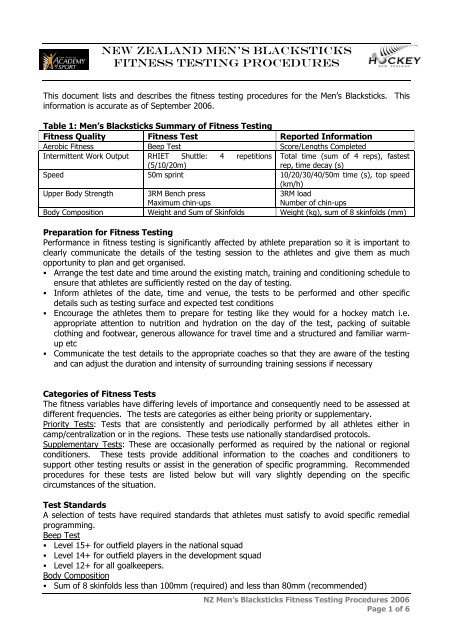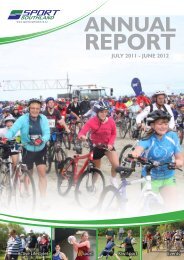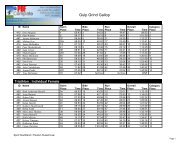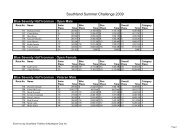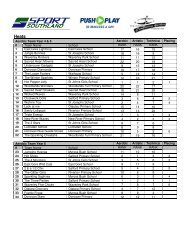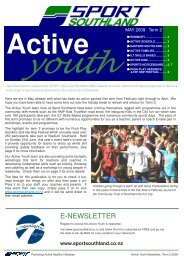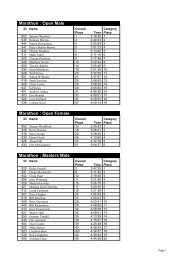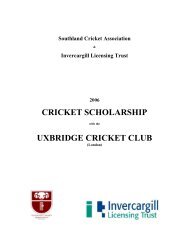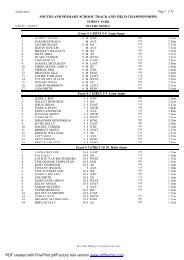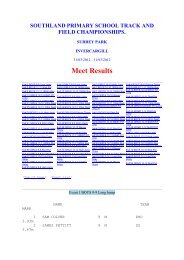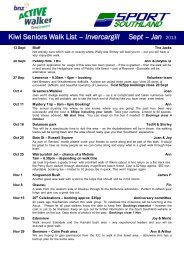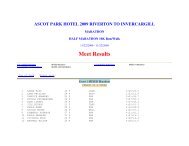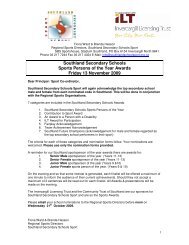NEW ZEALAND MEN'S BLACKSTICKS
NEW ZEALAND MEN'S BLACKSTICKS
NEW ZEALAND MEN'S BLACKSTICKS
Create successful ePaper yourself
Turn your PDF publications into a flip-book with our unique Google optimized e-Paper software.
<strong>NEW</strong> <strong>ZEALAND</strong> MEN’S <strong>BLACKSTICKS</strong><br />
FITNESS TESTING PROCEDURES<br />
This document lists and describes the fitness testing procedures for the Men’s Blacksticks. This<br />
information is accurate as of September 2006.<br />
Table 1: Men’s Blacksticks Summary of Fitness Testing<br />
Fitness Quality Fitness Test Reported Information<br />
Aerobic Fitness Beep Test Score/Lengths Completed<br />
Intermittent Work Output RHIET Shuttle: 4 repetitions Total time (sum of 4 reps), fastest<br />
(5/10/20m)<br />
rep, time decay (s)<br />
Speed 50m sprint 10/20/30/40/50m time (s), top speed<br />
(km/h)<br />
Upper Body Strength 3RM Bench press<br />
Maximum chin-ups<br />
3RM load<br />
Number of chin-ups<br />
Body Composition Weight and Sum of Skinfolds Weight (kg), sum of 8 skinfolds (mm)<br />
Preparation for Fitness Testing<br />
Performance in fitness testing is significantly affected by athlete preparation so it is important to<br />
clearly communicate the details of the testing session to the athletes and give them as much<br />
opportunity to plan and get organised.<br />
• Arrange the test date and time around the existing match, training and conditioning schedule to<br />
ensure that athletes are sufficiently rested on the day of testing.<br />
• Inform athletes of the date, time and venue, the tests to be performed and other specific<br />
details such as testing surface and expected test conditions<br />
• Encourage the athletes them to prepare for testing like they would for a hockey match i.e.<br />
appropriate attention to nutrition and hydration on the day of the test, packing of suitable<br />
clothing and footwear, generous allowance for travel time and a structured and familiar warmup<br />
etc<br />
• Communicate the test details to the appropriate coaches so that they are aware of the testing<br />
and can adjust the duration and intensity of surrounding training sessions if necessary<br />
Categories of Fitness Tests<br />
The fitness variables have differing levels of importance and consequently need to be assessed at<br />
different frequencies. The tests are categories as either being priority or supplementary.<br />
Priority Tests: Tests that are consistently and periodically performed by all athletes either in<br />
camp/centralization or in the regions. These tests use nationally standardised protocols.<br />
Supplementary Tests: These are occasionally performed as required by the national or regional<br />
conditioners. These tests provide additional information to the coaches and conditioners to<br />
support other testing results or assist in the generation of specific programming. Recommended<br />
procedures for these tests are listed below but will vary slightly depending on the specific<br />
circumstances of the situation.<br />
Test Standards<br />
A selection of tests have required standards that athletes must satisfy to avoid specific remedial<br />
programming.<br />
Beep Test<br />
• Level 15+ for outfield players in the national squad<br />
• Level 14+ for outfield players in the development squad<br />
• Level 12+ for all goalkeepers.<br />
Body Composition<br />
• Sum of 8 skinfolds less than 100mm (required) and less than 80mm (recommended)<br />
NZ Men’s Blacksticks Fitness Testing Procedures 2006<br />
Page 1 of 6
Aerobic Fitness - Beep Test (Priority Test)<br />
• The 20m beep test is to be performed either indoors or on a hockey turf<br />
• An authentic (not computer burnt) Beep Test CD must be used<br />
• All athletes must start from level 1.1<br />
• Athletes are to be given two consecutive warnings before being withdrawn from the test. The<br />
last successfully completed length is their score.<br />
• When administering the test it is recommended to remind the participants that the test is<br />
maximal and to encourage them push for each additional length.<br />
Required Information<br />
• Test score for each athlete (level and lengths i.e. level 15.01, 145 lengths)<br />
• Date, time of the day, day of the week<br />
• Surface: turf, gym floor<br />
• Rested state: briefly describe the current state of physical load for the test participants (Wellrested,<br />
lightly rested, under moderate load, under heavy load)<br />
Also list any miscellaneous related details:<br />
• If the test was performed on a gym floor was it slippery due to humidity<br />
• Did any of the participants report any symptoms of injury or illness prior to (or after) the test or<br />
have altered physical loading to the other athletes (e.g. working a labour intensive job,<br />
returning from injury or on a special conditioning programme)<br />
Additional Information<br />
• Maximum heart rate - this can most reliably be gained using team polar heart rate straps and<br />
Polar Precision Performance software.<br />
Information Reported to Athletes<br />
• Beep test score/level e.g. 15.1<br />
• Lengths completed e.g. 145<br />
• Previous results, personal best, relevant required standards<br />
Aerobic Fitness - 5km Time Trial (Supplementary Test)<br />
To be performed on a region specific (e.g. North Harbour, Auckland, Wellington, Christchurch) and<br />
standardised course. The course should be as flat as possible and have minimal time-cost<br />
obstacles e.g. busy roads to cross. Athletes should be encouraged to run with a watch and if<br />
possible, a heart rate monitor.<br />
Current Venues:<br />
• North Harbour: Lake Pupuke<br />
• Auckland: Tamaki Drive<br />
• Christchurch: Hagley Park<br />
Required Information<br />
• Time for each athlete<br />
• Date, time of the day, day of the week<br />
• Venue/Course: brief description i.e. road, track, park, flat, a few slight hills, multiple laps, 1 lap<br />
etc<br />
• Test conditions: general description of temperature, humidity and wind<br />
• Rested state: briefly describe the current state of physical load for the test participants<br />
• Well-rested, lightly rested, under moderate load, under heavy load<br />
Miscellaneous details:<br />
• Did any of the participants report any symptoms of injury or illness prior to (or after) the test or<br />
have altered physical loading to the other athletes (e.g. working a labour intensive job,<br />
returning from injury or on a special conditioning programme)<br />
NZ Men’s Blacksticks Fitness Testing Procedures 2006<br />
Page 2 of 6
Additional Information<br />
• Lap splits if applicable<br />
• Whether the athlete perceived himself to have run a good “race” i.e. did he report that he went<br />
out too hard or too slow or ok<br />
Information Reported to Athletes<br />
• Final 5km time<br />
• Lap splits where applicable<br />
• Previous results, personal best, relevant required standards<br />
Intermittent Work Output – RHIET/Repeated High Intensity Endurance Test (Priority<br />
Test)<br />
• The RHIET is to be performed either indoors or on a hockey turf<br />
• Cones are placed at 0m, 5m, 10m and 20m as shown in the diagram below<br />
5m 10m 20m<br />
RHIET: Perform each<br />
rep at maximum effort.<br />
• Athletes are instructed to perform each rep as fast as possible. Run from the start line to the<br />
5m line and back then to the 10m line and back and finally to the 20 line and back. The time<br />
starts and finishes as they cross the start line.<br />
• Athletes must touch the line with their foot on each turn.<br />
• A total of 4 repetitions are performed with each repetition starting 30 seconds after the<br />
previous one (rep 1 starts on 0:00, rep 2 on 0:30, rep 3 on 1:00, rep 4 on 1:30)<br />
• If an athlete gets faster by more than 1 second on consecutive reps and/or the last repetition is<br />
the fastest then the test data is not valid and the test must be repeated at another time.<br />
Required Information<br />
• 4 shuttle times for each athlete<br />
• Date, time of the day, day of the week<br />
• Timing system used: stopwatch, electronic timing lights (and type)<br />
• Surface: turf, gym floor<br />
• Rested state: briefly describe the current state of physical load for the test participants<br />
• Well-rested, lightly rested, under moderate load, under heavy load<br />
Miscellaneous details:<br />
• If on a gym floor was it slippery due to humidity<br />
Information Reported to Athletes<br />
• 4 shuttle times<br />
• Total time (sum of 4 repetitions)<br />
• Fastest repetition<br />
• Time decay (difference between fastest and slowest repetition)<br />
• Previous results, personal best, relevant required standards<br />
Speed - Straight line Speed (Supplementary test)<br />
• Testing can be performed indoors or outdoors on wood, rubber or turf surfaces. Testing should<br />
not be performed on grass.<br />
• If testing outdoors, care should be taken to avoid significant head or tail-wind situations<br />
• If testing indoors, a sufficient and appropriate run-off distance must be provided to ensure that<br />
athletes do not slow down before the 50m gate<br />
NZ Men’s Blacksticks Fitness Testing Procedures 2006<br />
Page 3 of 6
• A set of dual beam or triple beam timing lights is to be used (single beam timing lights are not<br />
appropriate)<br />
• Gates are set at 0m, 10m, 20m, 30m, 40m, 50m<br />
• The height of the gates should be set such that the lowest beam is between mid-thigh and hip<br />
level<br />
• A line is drawn 30cm back from the first gate and the athletes front foot must be behind this<br />
line<br />
• Athletes can start a trial when ready but must not rock backwards before moving forwards<br />
• 2-3 trials are allowed per athlete with a rest period of at least 2 minutes between reps<br />
Required Information<br />
• Times for each athlete for each distance and each trial<br />
• Date, time of the day, day of the week<br />
• Timing system used: e.g. swift dual beam etc<br />
• Surface: turf, track or wooden gym floor<br />
• Wind direction and strength if outdoors<br />
Information Reported to Athletes<br />
• Time for each split<br />
• Top speed (km/h) – taken as the fastest 10m split<br />
• Previous results, personal best, relevant required standards<br />
Agility (Supplementary test)<br />
Option 1: 1 repetition of a RHIET shuttle<br />
5m 10m 20m<br />
• One timing gate is used for both the start and the finish. It is set on the 0m line.<br />
• A line is drawn 30cm back from the gate/0m line and the athletes front foot must be behind<br />
this 30cm line.<br />
• Athletes can start a trial when ready but must not rock backwards before moving over the start<br />
line.<br />
• 2 trials are allowed per athlete with no less than 3 mins rest period between reps (if an athlete<br />
slips then an additional trial is permitted)<br />
Option 2: 10-10<br />
10m<br />
• The test is to run around a cone/pole that is 10m away and back to the start. Athletes can<br />
choose which way they run around the cone (right or left).<br />
• One timing gate is used for both the start and the finish. It is set on the 0m line.<br />
• A line is drawn 30cm back from the gate/0m line and the athletes front foot must be behind<br />
this 30cm line.<br />
• Athletes can start a trial when ready but must not rock backwards before moving over the start<br />
line.<br />
NZ Men’s Blacksticks Fitness Testing Procedures 2006<br />
Page 4 of 6
• 3 trials are allowed per athlete with no less than 90s rest between reps (if an athlete slips then<br />
an additional trial is permitted)<br />
Required Information<br />
• Times for each athlete for each trial<br />
• Date, time of the day, day of the week<br />
• Timing system used: e.g. swift dual beam etc<br />
• Surface: turf, track or wooden gym floor<br />
• Wind direction and strength if outdoors<br />
Information Reported to Athletes<br />
• Best time<br />
• Previous results, personal best, relevant required standards<br />
Body Composition - Weight and Sum of Skinfolds (Priority Test)<br />
• Standard ISAK procedures are to be followed<br />
• Slimguide or other ISAK approved calipers must be used<br />
• Scales should be regularly calibrated and be both valid and reliable<br />
Required Information<br />
• Weight (kg)<br />
• Height (cm)<br />
• ISAK Sum of 8 Skinfolds (Subscapular, Triceps, Biceps, Iliac Crest, Supraspinale, Abdominal,<br />
Thigh, Calf)<br />
• Site measurements<br />
• Calipers used<br />
• Scales used<br />
Information Reported to Athletes<br />
• Weight, height and sum of skinfolds<br />
• Previous results, personal best, relevant required standards<br />
• Recommendations and feedback<br />
Upper Body Strength - Barbell Bench Press 3RM (Supplementary Test)<br />
A flat bench is used with an Olympic bar (20kg). If collars are used then their weight (if any) must<br />
be added to the total lift load. During the lift a spotter should be present to assist and promote<br />
safety. The spotter can help to lift the bar off the rack, letting go of the bar when the athlete is in<br />
full elbow extension and ready to begin the descent of the first repetition.<br />
Each repetition must lightly touch the chest and finish at full elbow extension. Bouncing the bar<br />
off the chest is not permitted and the hips, head and shoulders should be in contact with the<br />
bench at all times. The spotter can then help to return the bar back to the rack.<br />
Upper Body Strength - Maximum Chin-Ups (Supplementary Test)<br />
The chin-ups are performed with a shoulder-width underhand grip (palms facing backwards).<br />
Each repetition starts and finishes with the elbows straight. The chin must touch or go above the<br />
height of the bar to be counted as a completed repetition. No swinging or kicking of the legs or<br />
hips is allowed. The test administrator can stop swinging of the body during the test by placing a<br />
hand on the lower back.<br />
Required Information<br />
• 3RM load recorded for each athlete<br />
• Load and details of any failed attempts e.g. 75kg, 2 reps completed but failed on 3 rd<br />
• Number of chin-ups performed by each athlete<br />
NZ Men’s Blacksticks Fitness Testing Procedures 2006<br />
Page 5 of 6
Information Reported to Athletes<br />
• 3RM bench press load<br />
• Number of chin-ups completed<br />
• Previous results, personal best, relevant required standards<br />
Test Data Management<br />
All test data is to be held by:<br />
The Lead Strength and Conditioner<br />
• John Lythe: fitter@slingshot.co.nz<br />
Men’s Blacksticks National Coach<br />
• Kevin Towns: kevin@nzhockey.org.nz<br />
NZ Men’s Blacksticks Fitness Testing Procedures 2006<br />
Page 6 of 6


